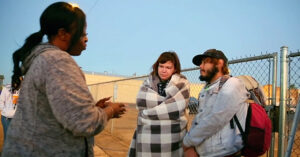In the second episode of our Community Collaborative Series, our community leaders build on the discussion of Episode 1 with insights on how organizations can take action on diversity and inclusion initiatives in the current climate.
Both Community Collaborative co-hosts/producers, Black Chamber of Arizona CEO Robin Reed and Arizona Hispanic Chamber of Commerce CEO Monica Villalobos, kick off the episode with appreciation that companies are reaching out for help. They observe that some companies want to take action but are unsure of how to approach discussions. Villalobos and Reed stress the importance of involving many cultures in those discussions—the very mission and purpose of the Community Collaborative—while taking meaningful and positive actions in rolling out diversity and inclusion programs.
Reed states, “Repeat a positive. It’s very easy in a volatile climate to focus very much on the negative impact or the things you don’t like. However progress is made when you move toward the outcome you’re looking for. We really want to make sure…we’re identifying those positive things that are happening and then repeating them.”
Joining Reed and Villalobos are, in order of appearance, Tim Overton, Dickinson Wright PLLC attorney and appointed member of the Arizona Commission of African American Affairs; Susan Anable, vice president of Government and Public Affairs for Cox Communications; Michael Marcinko, vice chair of the Greater Phoenix Equality Chamber of Commerce; and Vic Reid, CEO of the Arizona Asian Chamber of Commerce
To guide the discussion, the co-hosts prompt the contributors with two questions all companies should ask themselves:
- – How do we indicate if progress is being made?
- – How do we avoid having the same conversation year after year when an incident occurs in society?
Don't Miss These Highlights
In response, Tim Overton outlines the steps organizations should take in designing and refining a diversity and inclusion program (6:44), including:
- – Bias training to empower organizations with the current vocabulary to approach discussions
- – Diversity & inclusion audit to provide data organizations can use to measure progress
Susan Anable discusses how a company with a long history of diversity and inclusion must tailor their program to current events (12:32). She shares steps Cox Communications has taken, recognizing that employees’ needs and views change over time and especially so after highly publicized incidents occur.
Michael Marcinko (17:30) explains how organizations approach his and other chamber organizations to put a diversity and inclusion plan into action whether the companies have a long history of diversity and inclusion programs or they don’t know where to start.
Vic Reid (24:45) points out that organizations and individuals need to recognize the prevalence of implicit bias and the individuality within each cultural group. Using the Asian Pacific community as an example, he shares that there are 60 countries represented in that group, each with its own rich history of religion, food, language, and life experiences.
“The first step in really moving forward is dropping any preconceived notions that you might have…We are not a monolith. When we talk about diversity and inclusion, we lump everything into one lump sum. But that’s not reality. As individuals, we are very complex. We have different life experiences. And that’s the great thing about diversity is that we’re able to learn from different perspectives because of those experiences.”
Diversity and Inclusion Actions Organizations Should Take:
Important takeaways from Episode 2 include:
- – Focus on the result you want, not the negative
- – Learn the current vocabulary to use in diversity and inclusion discussions (6:25)
- – Collect data now and along the way to measure progress (7:12)
- – Give employees space outside of human resources to share their concerns and ideas (27:39)
- – Involve multiple cultures in discussions
- – Listen (26:20)
- – Consult both internal and external resources (10:57 & 31:11)
- – Partner with multiple chamber organizations to help identify blind spots and community activities to support and get access to additional resources
- – Collect data and measure progress
- – Develop policies and processes for attracting diverse candidates (8:40), especially for high- and mid-level roles and not just entry-level (19:54)
- – Maintain mentor programs (29:23)
The underlying theme that’s emerged from the first two Community Collaborative discussions is the importance of involving multiple cultures in diversity and inclusion discussions and actions. Various chamber organizations are continuing to support each other during this time of civil unrest.
Likewise, companies should be including multiple cultural external and internal groups in their efforts to take positive action to develop effective diversity and inclusion programs and measure progress. Companies are not alone in their efforts. There are many community resources available to help support those efforts and educate on the best paths forward.
About The Community Collaborative
Community and business leaders and individuals who want to educate themselves on diversity issues will find the series informative and educational. And anyone who wishes to get involved will have ready access to resources featured in each program.
The video series may be streamed for free through the STN app. Viewers may subscribe through STN’s website or by downloading the STN app on the App Store or Google Play.
Each program in the series will provide details on how to get involved in featured activities and initiatives. To be featured in “The Community Collaborative” series or other STN programming, contact us at 480.967.7088.
Every day, there are leaders on the front lines of the fight to improve life in our community. STN provides the platform to tell their and their communities’ stories with video series on leadership philosophies and active efforts to make positive change in our region.





